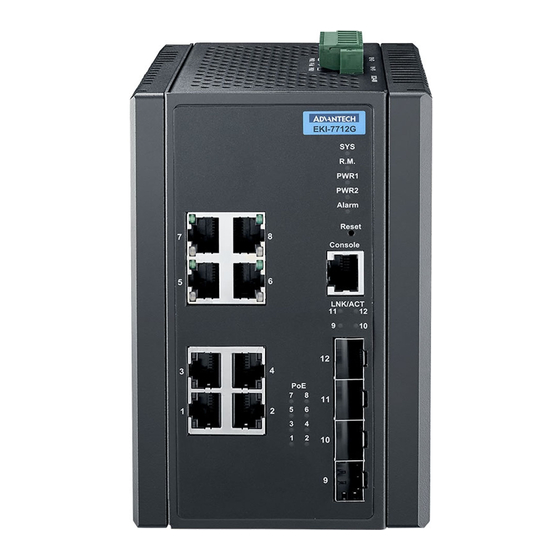
Advantech EKI-7712G-4FMPI Ethernet Switch Manuals
Manuals and User Guides for Advantech EKI-7712G-4FMPI Ethernet Switch. We have 1 Advantech EKI-7712G-4FMPI Ethernet Switch manual available for free PDF download: User Manual
Advantech EKI-7712G-4FMPI User Manual (169 pages)
8GE + 4G SFP Port Managed Redundant High PoE Industrial Switch
Table of Contents
-
-
Front View17
-
Rear View19
-
Top View20
-
Dimensions20
-
-
Overview31
-
Reset Button35
-
-
Overview37
-
Introduction37
-
System Login41
-
-
Log in43
-
Monitoring44
-
System52
-
IP Settings52
-
System Time56
-
Network Port57
-
L2 Switching58
-
Port Mirror59
-
Q Vlan62
-
Q-In-Q66
-
Garp67
-
Az EEE69
-
Multicast70
-
Jumbo Frame75
-
X-Ring Elite82
-
X-Ring Pro83
-
Erps87
-
Static MAC88
-
Security90
-
Applications95
-
IP Security98
-
IP Source Guard104
-
DHCP Snooping105
-
ARP Spoofing107
-
Qos107
-
General107
-
Qos Basic Mode113
-
Rate Limit114
-
Management118
-
Lldp118
-
Snmp122
-
DHCP Server128
-
SMTP Client133
-
Rmon136
-
NTP Server140
-
Diagnostics141
-
Ping Test141
-
Ipv6 Ping Test142
-
System Log143
-
DDM145
-
LED Indication146
-
Tools147
-
IXM147
-
Backup Manager147
-
Upgrade Manager148
-
Dual Image149
-
User Account150
-
N-Key150
-
Reset System151
-
Reboot Device151
-
-
-
Troubleshooting168
-
Advertisement
